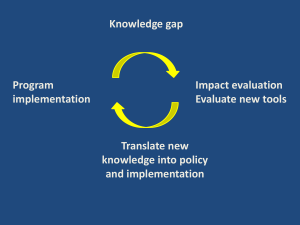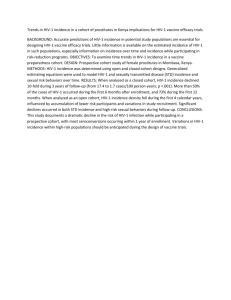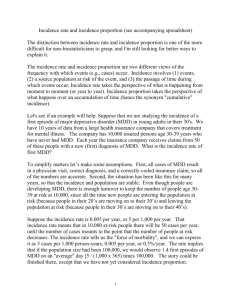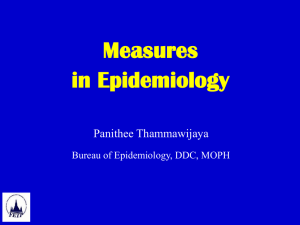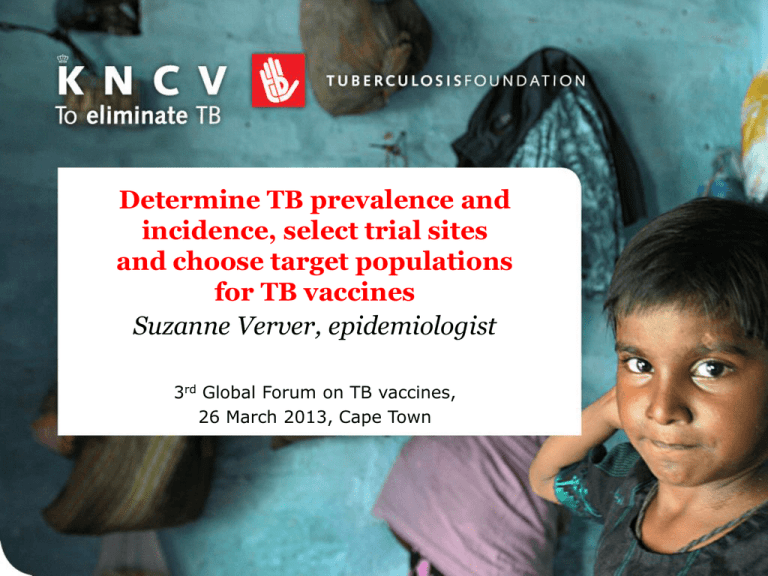
Determine TB prevalence and
incidence, select trial sites
and choose target populations
for TB vaccines
Suzanne Verver, epidemiologist
3rd Global Forum on TB vaccines,
26 March 2013, Cape Town
Outline
•
•
•
Choose target populations
Epi studies to determine TB prevalence and incidence
Select trial sites: hotspots
Target groups
•
•
•
•
•
•
•
•
Infants
Easy to access
Include vaccine in EPI
Slow effect on epidemic
Adults
Highest incidence
The older the more stable
More difficult to access and
follow-up
• High risk groups: HIV infected,
urban population
• Adolescents 12-18
• Mix pre- and post-infection (South
Africa 50%)
• Easy to access;
• the younger the easier to followup but the lower the incidence
• Probably need to be included for
licensure
WHO TB impact working group mtg 2010 background paper no 9 by Ana Bierenbach
WHO TB Impact working group mtg 2010 background paper no 9 by Ana Bierenbach
Objectives of epidemiological studies to
prepare for vaccine trials
• To assess TB prevalence (adolescents) & incidence
• To assess proportion MTB infected
• To assess comorbidities (Malaria, HIV) & mortality (verbal
autopsy) and strategies to reduce these
• To assess recruitment and cohort retention strategies
• To assess yield of different case finding strategies and
diagnostic algorithms
• To assess current coverage of BCG & EPI
• To build capacity for vaccine trials
Assess TB incidence and prevalence:
Cohort studies (see poster 43)
• Adolescent cohort studies and neonatal cohort studies
• South Africa (SATVI): compare active and passive case finding strategies
– ACS (n=6363) ; NCS (n = 4786)
– Moyo Int J Tuberc Lung Dis 2012; Mahomed PlosOne 2013
• India, Kenya and Uganda:
– NCS (n~2500-2900); ACS (n~5000)
– publications ongoing
• Excellent studies but took > 5 years to get results
Alternative designs
• Infants:
– Shorter cross sectional study among infants 0-3 yr to assess period
prevalence (CHC Cambodia and CISM Mozambique): challenges to
assign prevalent and incident cases
• HIV infected adults:
– Retrospective paper based cohort study to estimate TB incidence
among HIV infected adults: link TB and HIV records and compare to
district data (Aurum, South Africa): challenges to link records
– Combined retrospective and prospective estimate of TB incidence
among HIV infected persons: South Africa (Aurum) and Tanzania
(Ifakara in Bagamoyo): analysis ongoing
– Estimates change with IPT and ART use
No quick way to get accurate incidence estimates
Lessons from neonatal cohort studies for trials
• Number of culture positive cases small -> adapted endpoints (Moyo 2012)
• Active case finding finds more cases, and they are equally severe as in
passive group -> decided to use active follow-up in future trials (Moyo
2012)
• High mortality needs mortality reduction strategies (Nabongo submitted)
• High concordance TST and quantiferon, but low sensitivity for TB disease > both tests needed (Moyo 2011)
• Large proportion of participants was suspects and needed admission in
ward; -> more efficient ways? (Moyo 2012)
• Importance of testing mother and infant for HIV (in prep)
• Relevance of surveillance of TB treatment registers (Moyo 2012)
• Enrollment strategies (Moyo 2012)
• Relevance of harmonization of CXR reading (Wajja in prep)
Lessons from adolescent studies for trials
•
Proportion LTBI differed by site: in South Africa 50% (Mahomed 2011).
•
Adolescents with positive TST and/or Quantiferon have higher TB incidence than those
with no infection at baseline (Mahomed 2011). Quantiferon converters have 9x higher
risk to develop TB (Machingaidze 2012).
•
Relevance of surveillance site specific: in SA half the cases detected through regular
health system but not in Uganda (Mahomed 2013)
•
Differences between specific schools (Mahomed 2013)
•
Ruler and calliper comparable for TST (Geldenhuys 2010)
•
Low proportion smear-positive: early case finding leads to less severe cases (Waako
submitted)
•
TB among adolescents not HIV related; probably due to high transmission (Mahomed
2013, Nduba submitted, Waako submitted)
•
High proportion non-tuberculous mycobacteria (Asiimwe 2013)
•
Usefulness of early morning sample (Ssengooba 2013)
Learn lessons during preparatory epi studies
rather than during trials*?
• Cheaper since no investigational product, less ethical requirements, less
intensive follow-up for adverse events, less screen failures
• Do not want to make errors in trials
• Capacity building
• In infants no quick and easy way to obtain incidence; and highest in third
year
• Adaptive designs also need some estimates
• Lessons applicable to several groups (eg adolescents/adults)
• Epi studies can identify high risk groups (smokers, urban slums)
• Epi studies can collect samples for biomarkers
Lessons from trials see Tameris 2012
Challenge of epi studies
• Define scientific objectives:
– add on studies,
– biomarkers
– link with questions of national TB control programmes
• Takes more time
• Need to analyse data in detail to predict numbers for more
strict exclusion criteria in trial
Develop trial sites
HIV/malaria vaccine trial sites
TB diagnostic/drug trial sites
•
•
•
•
•
•
•
TB epidemiology: calculate expected
number of TB suspects, LTBI and TB cases
by type.
Clinical: CV ward, tuberculin skin testing,
gastric washing, induced sputum,
harmonize chest x-ray reading of nonsevere cases
Laboratory: TB culture capacity for large
number of samples with low proportion
positive ; sample handling
TB treatment start and follow-up for
outcome
Collaborate with TB control programme
Community knowledge, attitudes and
practice
•
TB epidemiology: calculate expected
number of TB suspects, LTBI and TB cases
by type.
Clinical; depends on target group
•
Lab: expand capacity
•
Follow-up of large cohort by routine
screening
Community knowledge, attitude and
practice & work with community in
general
•
TB hotspots – HIV negative adults
Find geographical hotspots within countries
•
•
•
•
Use NTP data by district/subdistrict
Calculate TB incidence among HIV uninfected = A*(1-B)/C*(1-D)
A = number of TB cases notified
B = proportion of TB cases co-infected with HIV
C = population
D = proportion of the population HIV infected
Limitations: differences in age, sex, underdiagnosing & underreporting of TB
and HIV, mortality, population estimates
Literature review on TB incidence among HIV negative persons (Mitchell et al in
preparation):
• Very little information: IPT trials, active case finding/screening studies,
prevalence surveys
Use modelling
TB incidence in trial differs from
notified incidence
Expect a decrease due to:
• Strict selection criteria
• Exclusion of high risk groups
• Exclusion of prevalent cases:
wash out effect
• Early case finding & preventive
therapy
Expect an increase due to:
• Under notification: assess by
inventory studies
• Under diagnosis
Notified cases may not cover the age category or geographical area
where the trial takes place
• Study to quantify the level of
under-reporting of diagnosed
cases of TB to national
surveillance systems.
• Compare the number of cases
recorded in public and private
health facilities with the
records of cases notified
• To estimate TB incidence using
capture–recapture methods.
• Need 3 fairly independent data
sources
• Use record linkage
• Simpler:
– assess initial defaulters
– Assess cases lost from
hospital referrals
– Collaborate private sector
Under diagnosis: develop hotspots
Improve current case finding of health system
by:
• Improving diagnostics
• establishing contact tracing
• Following up all suspects and make sure they do not get lost in
system
• Needs collaboration with TB control programmes and private
sector
Acknowledgements
•
•
•
•
KNCV: Ellen Mitchell
Sites:
• SATVI/UCT South Africa
• KEMRI/CDC, Kisumu Kenya
• IDI/Makerere Uganda & TB team Iganga/Mayuge
• CISM Mozambique
• Aurum South Africa
• Ifakara Institute Tanzania
Partners/funders:
• GSK biologicals, Belgium
• Aeras, USA
• EDCTP
• ITM Belgium
• Karolinska Institute, Sweden
More info: ververs@kncvtbc.nl; www.kncvtbc.org



